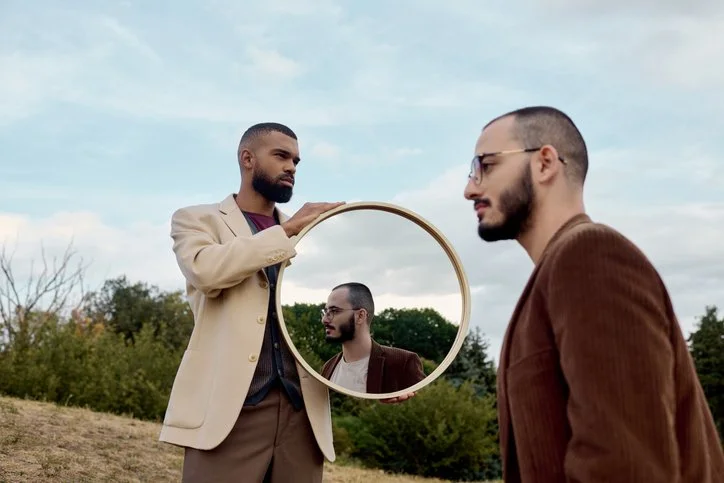All That We See in Others is a Reflection of Ourselves
By Joy Stephenson-Laws, Holistic Coach, J.D., Founder
Understanding How Our Inner World Shapes Our Outer Experience
Have you ever noticed that the things that bother you the most about other people are sometimes the things you struggle with yourself? Or that the people you admire often have qualities you want to grow in?
There’s a powerful saying:
"All that we see in others is a reflection of ourselves."
At first, this idea can feel confusing. You might think, "Wait, I don't act like them! How is that a reflection of me?" But when we really understand this concept, it can completely change the way we see the world — and ourselves.
Recent psychology research supports this idea too. Scientists have found that we often project our own feelings, traits, and insecurities onto others, sometimes without even realizing it. A 2022 study in Frontiers in Psychology showed that people unconsciously assign traits they dislike about themselves to others, as a way to protect their self-image (Hu et al., 2022).
Let’s explore this idea with examples and find out how we can use it to become better, happier people.
What Does This Quote Really Mean?
The quote suggests that when we react strongly to someone — whether with admiration or frustration — it’s not really about them. It's about something inside of us.
Sometimes, we recognize parts of ourselves in others — parts we like or parts we try to hide. It’s almost like other people are mirrors, showing us what we need to see.
Psychologists call this projection. As explained by Robbins and Krueger (2021) in a major review, social projection is when we assume that others feel or act the same way we do — even if they don't. Our minds do this automatically to make sense of the world around us.
In simple terms:
When you love something about someone, it might be a quality you have or want to grow.
When you hate something about someone, it might point to a hidden part of yourself you haven't accepted yet.
Understanding Projection: A Simple Example
Imagine this:
You have a classmate named Alex who always speaks loudly and takes charge in group projects. You feel really annoyed by Alex. You might think, "Why is Alex so bossy? I can't stand people like that."
But if you look deeper, you might realize that:
You actually wish you could speak up more yourself.
Or maybe you were taught when you were younger that being loud was “bad,” so you feel uncomfortable when someone else acts that way.
Or maybe you're afraid that if you were more confident, others would dislike you — so you judge Alex instead.
According to studies, such as by Weidman et al. (2020) published in Emotion, emotional projection often comes from feeling threatened internally. It's a defense system your mind uses to avoid painful feelings.
Other Real-Life Examples of Reflection and Projection
1. Admiration Example:
You admire your friend Mia because she’s super kind to everyone.
Maybe you are also very kind but you don't always notice it.
Or maybe you want to become more openly caring, like Mia.
2. Annoyance Example:
You get angry at someone who is always seeking attention.
Maybe you secretly want more attention but feel guilty about it.
Maybe you were taught that needing attention is selfish, so you judge it in others.
3. Jealousy Example:
You feel jealous of your teammate who gets a lot of praise.
Maybe you wish you could shine more but you’re afraid of failure.
Maybe you think you’re not good enough, and their success reminds you of that insecurity.
Psychologists have found that when people feel insecure or unsure about themselves, they are much more likely to project those feelings onto others (Hu et al., 2022).
Why Does This Matter?
If we don't understand that others reflect parts of ourselves, we can fall into these traps:
Blaming others for how we feel.
Missing opportunities to grow and change.
Staying stuck in negative patterns.
Hurting our relationships because we expect others to "fix" our feelings.
Research from the Journal of Positive Psychology (Zhang et al., 2020) also shows that people who practice self-reflection — looking at their own thoughts and actions honestly — feel more authentic and live more meaningful lives.
So when we recognize reflection and projection in our daily life, we get a powerful tool to become more real and fulfilled.
How to Change Your Reflection
Here’s a simple 4-Step Reflection Process you can use:
1. Pause and Notice Your Reaction
When you feel annoyed, jealous, frustrated, or even overly impressed, stop and notice it.
Don't rush past it. Say to yourself:
"I'm feeling really triggered right now."
"I'm feeling very impressed by this person."
Just noticing your feelings is the first act of wisdom.
2. Ask: What Does This Say About Me?
Instead of focusing on what’s wrong with the other person, ask:
"Is this something I struggle with?"
"Is this something I secretly want?"
"Is this something I was taught was wrong or scary?"
Psychologists call this taking back your "projection" — bringing the focus back to your inner world.
3. Accept, Don’t Judge
Whatever you find inside yourself — be kind to it.
Remember: we all have strengths and weaknesses. We all have dreams and fears. It's okay to have hidden parts.
You might say:
"It’s okay that I want more attention."
"It’s okay that I wish I were more confident."
Acceptance is a key part of healing, supported by findings from emotional health research (Weidman et al., 2020).
4. Choose How You Want to Grow
Once you’ve discovered what the reflection is showing you, decide what you want to do about it.
Here are some possibilities:
If you admire a quality, start practicing it yourself.
→ Admire someone’s confidence? Try speaking up more.If you are annoyed by something, find out what you need to heal inside yourself.
→ Feel annoyed at someone’s bragging? Maybe work on building your own healthy self-esteem.
As you grow, your reflections will change too.
An Inspirational Example: Changing the Reflection
Let’s look at a story:
Samantha always got annoyed at people who acted excited about their dreams. She thought, "They're so unrealistic. They’ll probably fail."
But after learning about projection, she realized she had given up on her own dreams because she was scared of failing.
Instead of staying bitter, Samantha decided to start dreaming again. She joined a writing club, set small goals, and let herself hope.
Now, when she sees people excited about their dreams, she smiles — because she’s excited about hers too.
Key Reminders:
Everyone is your teacher.
Even the annoying ones.Your emotions are clues, not facts.
They show you where to look inside yourself.You have the power to change.
By changing yourself, you change how you see others — and how you experience the world.
References:
Hu, X., Liu, J., Wang, S., & Xie, X. (2022). Unconscious projection of undesirable traits: Evidence from personality judgments. Frontiers in Psychology, 13, 892394.
Robbins, J. M., & Krueger, J. I. (2021). Social projection: A review of theoretical perspectives and empirical evidence. Social and Personality Psychology Compass, 15(4), e12555.
Weidman, A. C., Sowden, W. J., Berg, M. K., & Tracy, J. L. (2020). Emotional self-perception and defensive projection: The influence of threat. Emotion, 20(6), 1013–1024.
Zhang, J. W., Howell, R. T., & Stolarski, M. (2020). Looking into the mirror: Self-reflection increases authenticity. Journal of Positive Psychology, 15(2), 207–219.







